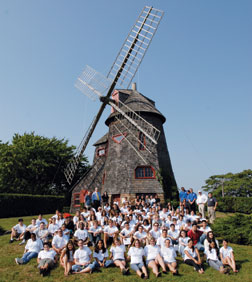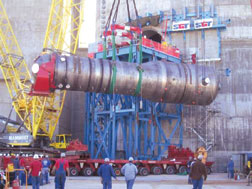 Suny, Stony Brook SUNY students on new South�ampton, N.Y., campus with icon of cleaner energy.
|
Both were once considered passé, but if Al Gore and atomic energy can resurge in the U.S., anything is possible. Mounting evidence of global warming’s impact has propelled the study of sustainability, reinvigorated nuclear engineering and made the ex-vice president a campus hero.
The concept of sustainability has been an academic discipline since the 1970s, when development of environmentally friendly materials, designs, strategies and nonpolluting technology such as nuclear power began showing up in curricula, educators say. But warnings of greenhouse-gas effects by scientists and popular media such as Gore’s Oscar-winning movie An Inconvenient Truth have galvanized academia to renewed action.
“The demand for education in sustainability is growing, not only in environmental sciences but in engineering, business, economics and nearly every other sector,” says Charles Redman, director of Arizona State University’s new School of Sustainability. “In this first graduate class at the school you will see civil engineers in class right alongside people who want to save the polar bears.”
|
"The major will create graduates with skills...that are in demand." —Mark Jacobson,
Civil-Environmental Engineering Professor, Stanford |
The Tempe-based school is at the vanguard of a new thrust in higher education to make sustainability the core of a variety of academic disciplines.
The school, which launched its first class of several dozen students in September, offers bachelor’s and master’s degrees and a Ph.D. in sustainability. It is the first school of its kind in the nation to focus solely on sustainability education and the first to offer undergraduates a track to pursue majors in it. Redman says that of the 28 graduate students enrolled in the program, about one-third have degrees in engineering. “It’s heavily focused on the built environment,” he says. “We are trying to marry engineering with urban planning.”
 |
"One-third of sustainability grad students have engineering degrees." —Charles Redman,
Director, School of Sustainability, Arizona State Univ. |
Redman expects the program to grow to 150 to 200 students within three years. Environmental issues are particularly relevant in Phoenix, where a heat-island effect brought on by growing urban sprawl in recent years is baking the area’s natural environment and threatening native flora and fauna.
While ASU has plunged headlong into sustainability, a number of other colleges and universities across the country are beginning to wade into the water. Dozens of schools are integrating new sustainability classes into curricula, with many combining educational tracks across disciplines, such as a business major that may require classes in environmental science or an economics or engineering major that would study atmospheric science.
This fall, Stanford University, Palo Alto, Calif., is offering for the first time an interdisciplinary major in atmosphere and energy through its school of engineering. “The major will create graduates with skills to do things that are in high demand,” says Mark Jacobson, civil and environmental engineering professor. “They will be coming up with creative solutions to global warming and pollution while also addressing energy needs.”
Stanford launched an atmosphere-energy program for graduate students three years ago and has seen the number of applicants grow from 37 in its first year to 70 currently. Jacobson says federal funding for atmosphere and energy programs has grown in recent years while funding for other disciplines has waned. Sustainability’s surge in academia is “an undisputed trend” based on “a perfect storm” of societal interest and concern over global warming and the geopolitical energy issues, he says. Graduates will fill demand in sectors from business and engineering to government and nongovernmental organizations, Jacobson points out.
In an innovative approach designed to introduce sustainability education across a wide range of disciplines, the State University of New York, Stony Brook, which purchased the former Southampton College in Southampton, N.Y., last year, has transformed that campus into a liberal arts college with a theme of environmental sustainability. It welcomed its first class of undergraduates this fall.
Interim Dean Martin Schoonen says the school is taking an interdisciplinary approach to design sustainability curricula. “It offers an environmental studies major this year, but will branch out into five new majors that are awaiting state approval, including undergraduate programs in sustainability studies, environmental design, policy, and planning, ecological studies and human impact and art, culture and theories,” he says.
The school is a work in progress, as faculty and donors design curricula where few models currently exist. “We are teaching environmental studies more broadly than before and trying to create a well-balanced sustainability program,” says Schoonen.
According to the Association for the Advancement of Sustainability in Higher Education, Lexington, Ky., the rise in sustainability education is evident. “Our membership went from 30 in 2005 to 400 now,” says Tom Kimmerer, executive director. “It’s clear to me and most others that sustainability is rapidly becoming an educational and societal trend.”
Most engineering and design schools now offer associate, bachelor’s and master’s degrees focused on sustainability. Kimmerer says. With more academic institutions committing to sustainable design and construction in campus facilities, Kimmerer says schools and educators also are “informally educating contractors about green building.” As more owners adopt sustainable building practices, he sees demand for green-thinking graduates.
Comeback
Also heating up is demand for nuclear engineers as the power supply makes a comeback as a cleaner alternative to fossil fuels. The number of schools offering degrees in nuclear engineering in recent years has tripled, says Michael Corradini, chair of the nuclear engineering and engineering physics department at the University of Wisconsin, Madison.
 Washington Group International Nuclear power is seen as cleaner alternative to fossilfuel.
|
With the recent submission of a permit application in Texas to build and operate the first nuclear plant in the nation in more than 30 years, demand for grads schooled in newer and safer design and construction techniques is expected to explode, educators say.
“We’ve seen the number of students in our nuclear engineering programs grow by a factor of four,” says Corradini. “Industry is reaching out to us and saying they need graduates who are conversant in nuclear technology.”
Likewise, the federal government is ramping up support of universities’ nuclear engineering and research programs, says John Gutteridge, director of university programs at the U.S. Dept. of Energy. He says the agency has helped fund about 40 university nuclear programs since 1997 to the tune of about $120 million in grants, which has assisted schools in starting up and expanding nuclear-engineering programs and upgrading research laboratories.
DOE is looking to reverse a dearth in nuclear engineers spawned by stagnation in the nuclear power sector following the 1979 Three Mile Island reactor accident in Pennsylvania. Many remaining experts are on the cusp of retirement age.
“In all universities in nuclear engineering there have been less than 600 graduates since 1997,” says Gutteridge. “That is not nearly enough. We need at least 300 to 400 per year to replace those who are retiring and keep up with new growth. We started taking steps in 1997 to get up to speed, but there will not be enough people in the next decade to keep up with growth.”
One encouraging development is Congress’s renewal of funds this year about $27 million for DOE’s efforts after two years in which grant funding was not even requested by the administration. “We recognized nuclear would make a comeback, and it is,” says Gutteridge.
 Related Links:
Related Links: 
Post a comment to this article
Report Abusive Comment